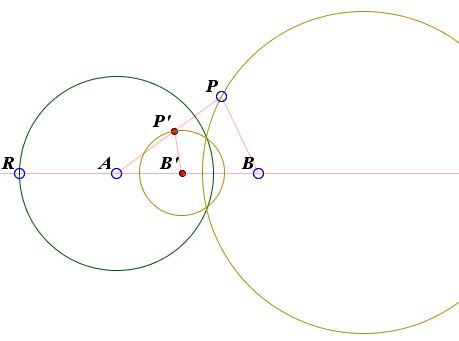Apollonian Circles Theorem
Given two points $A$ and $B$ and a number $r.$ What is the locus of points $P$ such that $AP/BP = r?$ The answer is a circle. The circle which is known as the Apollonian Circle. For every positive r there is a different one.
This problem has been treated elsewhere. Here we present a different solution based on the inversion transform. Along the way we show that the whole family of Apollonian circles can be inverted into a family of concentric circles.
|Activities| |Contact| |Front page| |Contents| |Geometry|
Copyright © 1996-2018 Alexander Bogomolny
Apollonian Circles Theorem
For two fixed points $A$ and $B$ and a real $r\gt 0,$ the locus of points $P$ such that $AP/BP = r$ is a circle. The circle is known as the Apollonian Circle.

Consider a circle of radius $R$ centered at $A.$ Let $t$ be the inversion in this circle. Set $t(B) = B'$ and $t(P) = P'.$ The calculations are simplified by taking $R = 1,$ but, in principle, any circle with center at $A$ will do. So, assume $R = 1.$
This means, in particular, that
(1)
$AP\cdot AP' = AB\cdot AB' = 1.$
Triangles $AB'P'$ and $APB,$ in which the sides satisfy (1), also share the angle at $A.$ They are, therefore, similar. It then follows that
(2)
$BP / B'P' = AB / AP'.$
From here,
(3)
$B'P' = BP\cdot AP' / AB.$
Combining (1) and (3) gives
(4)
$\begin{align} B'P' &= BP / (AP\cdot AB)\\ &= 1/rAB. \end{align}$
This tells us that $P'$ lies on a circle of radius $1/rAB$ centered at $B'.$ In other words, the inversive image of the locus of points $P$ is a circle centered at $B'.$ To repeat, the Apollonian circle defined by the point circles $A$ and $B$ and $r \gt 0$ is mapped by $t$ to a circle centered at $t(B).$ This is true for any Apollonian circle defined by $A$ and $B,$ so that the whole family of them is mapped on the family of concentric circles with center $t(B).$
In establishing Steiner's Porism we showed that any two non-intersecting circles can be inverted into a pair of concentric circles. The above strengthens this assertion with a more direct proof.
The Apollonian circles defined by two point circles are said to be coaxal. This is one of the three varieties of coaxal families.
References
- D. A. Brannan et al, Geometry, Cambridge University Press, 2002
Inversion - Introduction
- Angle Preservation Property
- Apollonian Circles Theorem
- Archimedes' Twin Circles and a Brother
- Bisectal Circle
- Chain of Inscribed Circles
- Circle Inscribed in a Circular Segment
- Circle Inversion: Reflection in a Circle
- Circle Inversion Tool
- Feuerbach's Theorem: a Proof
- Four Touching Circles
- Hart's Inversor
- Inversion in the Incircle
- Inversion with a Negative Power
- Miquel's Theorem for Circles
- Peaucellier Linkage
- Polar Circle
- Poles and Polars
- Ptolemy by Inversion
- Radical Axis of Circles Inscribed in a Circular Segment
- Steiner's porism
- Stereographic Projection and Inversion
- Tangent Circles and an Isosceles Triangle
- Tangent Circles and an Isosceles Triangle II
- Three Tangents, Three Secants
- Viviani by Inversion
- Simultaneous Diameters in Concurrent Circles
- An Euclidean Construction with Inversion
- Construction and Properties of Mixtilinear Incircles
- Two Quadruplets of Concyclic Points
- Seven and the Eighth Circle Theorem
- Invert Two Circles Into Equal Ones
|Activities| |Contact| |Front page| |Contents| |Geometry|
Copyright © 1996-2018 Alexander Bogomolny
73579748
